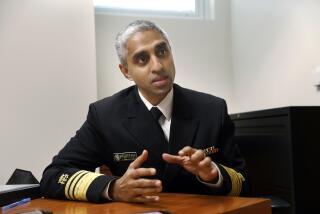It’s not exactly the Mayo Clinic
- Share via
RANTHAMBORE, India — The operating rooms are dark and gloomy, the power outages far too frequent; the layout is chaotic, and the recruitment of good doctors difficult.
Running a rural hospital in India is a labor of love marked by shortages, budget deficits and stiff competition from witch doctors and superstition — a tiny slice of the challenge India faces as it tries to lift hundreds of millions of people out of poverty.
Rupinder Kaur, executive director of Ranthambore Sevika Hospital in Rajasthan state, strides past villagers huddled on rickety benches into one of the four wards, her yellow scarf racing to keep up.
The hospital is at the end of a steep, bad road beside Ranthambore National Park, one of India’s most famous tiger reserves. The park attracts tourists from around the world, visibility that also helps bring in the occasional donation to Sevika.
The location is no accident. Founded in 1997, the hospital is run by the Prakratik Society, which believes in part that investing in local welfare is the best way to stem poaching and protect the tigers’ habitat.
But well-intentioned foreign donations go only so far. Though do-gooders are often happy to give medical equipment, most aren’t particularly keen on funding surgeries on a continued basis.
“Things are all dilapidated, but the equipment works and we’ve had to set our priorities,” said Kaur, pointing to an aging but working X-ray machine in a small operating room. “People may donate a generator, but it still needs fuel. It’s like getting an elephant that you have to feed.”
Most of Sevika’s patients are from hardscrabble villages that skirt the park, and many can’t afford the fees, which range from $100 for a Caesarean to $350 for cataract surgery, including glasses, room and board.
Sevika offers steep discounts as needed and operates at a 15% loss. This year it plans to move to nearby Sawai Madhopur, a city of 1.3 million about 180 miles southwest of New Delhi, where it hopes to attract more affluent patients to subsidize its rural base.
“We set up in the village,” said Dr. Goverdhan Singh Rathore, the hospital’s founder and son of conservationist Fateh Singh Rathore, known in India as the “Tiger Guru.” “But in hindsight, it wasn’t the best location.”
Satnarayan Saini, 45, a farmer from nearby Sherpur village who was in for a viral infection, said he comes to Sevika if his home remedies fail, including a paste made from flowers that he believes boosts immunity. The $2 he pays for a visit is relatively steep, he said, but worth it.
But some patients are rather selective in their payments and care options, a reflection of deep-seated societal biases. Sevika until recently had a neonatal facility, before it discovered that some parents would pay to save only the male infants. (Indian society has historically placed less value on females.) One woman who recently had fraternal twins, a boy and a girl, refused to breast-feed the girl, so the boy “wouldn’t get hungry.”
“What can you do?” Kaur said. “You do the best you can.”
Poor education is a constant problem for patients, many of whom, for instance, don’t understand the concept of medical specialization, demanding to see an ophthalmologist they once used even if they’ve just suffered a heart attack.
Doctors also must contend with widespread superstition and wives’ tales. Some parents place hot metal rods on their pneumonia-infected infants in the belief that the crying will “let out their heat.” Then there was the patient who arrived with an infection after inserting a rubber ball into her vagina to hold her prolapsed uterus in place. Doctors removed the ball, but the patient balked at surgery.
“It’s superstition; the ball is some traditional remedy,” Kaur said. “It can be very frustrating.”
Influenced by his father, Rathore returned to the area after medical school in 1989 and started attending to patients in 33 villages around the tiger park, traveling by van. Along with bandages, he passed out advice: Have fewer children, stop taking firewood from the reserve and report poachers. Eventually he realized the villagers’ greatest need was a hospital for more serious illnesses, and thus Sevika was born.
Although the hospital — three operating rooms, 10 specialists, three visiting surgeons — is privately run, most rural healthcare is delivered through government facilities.
India has set an ambitious goal of providing free universal healthcare by 2017 to its 1.2 billion citizens, about 70% of whom live rurally. Critics doubt this is feasible, and say that reforming the current system, strengthening oversight and rooting out corruption make more sense.
Doctors in government hospitals are allowed to have private practices on the side, for example, so many all but ignore their day jobs. And centralized procurement by bureaucrats with their own agendas often leaves hospitals lacking even basic medicines.
“There’s a real lack of political will,” said Dr. Abhay Shukla, a national rural health advisor. “If you can send a rocket to the moon, you should be able to deliver some tablets.”
Pilot programs in the states of Maharashtra and Tamil Nadu are incorporating patient feedback and a grading system for doctors, but reform is often slow going.
“No one likes to be held accountable,” Shukla said. “But it’s essential and needed to check corruption.”
Rural hospitals such as Sevika, one of the better examples, often find themselves winging it in line with a make-do national culture known as jugaad. Bed sheets are dried outside, but that creates problems during the monsoon, which is remedied by stringing up clotheslines at a nearby school after hours. “It’s always something,” Kaur said.
India, the largest supplier of foreign medical graduates to the United States, has only 1.3 doctors for every 10,000 people in the countryside, compared with 11.3 per 10,000 in urban areas. Hiring qualified staff is a constant challenge given the small pool, spotty work ethic and limited education, even among doctors. Sevika recently interviewed an eye doctor who didn’t know which side of his equipment to sit on.
Villagers often arrive when their illness is well advanced or terminal. Added to this are botched procedures by unlicensed practitioners or witch doctors, whose treatments maybe free or relatively cheap.
“The quacks do big damage, with patients arriving after bleeding for two days,” said Dr. Ram Singh Meena, Sevika’s general surgeon. “Then we’re left to clean up the mess.”
Tanvi Sharma in The Times’ New Delhi bureau contributed to this report.
More to Read
Sign up for Essential California
The most important California stories and recommendations in your inbox every morning.
You may occasionally receive promotional content from the Los Angeles Times.










